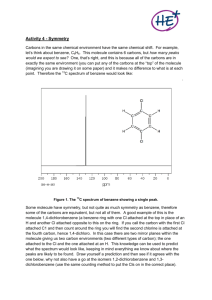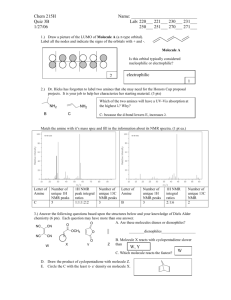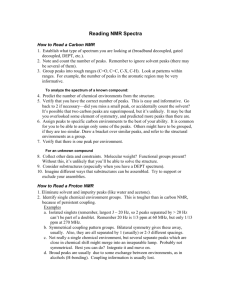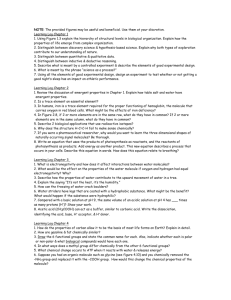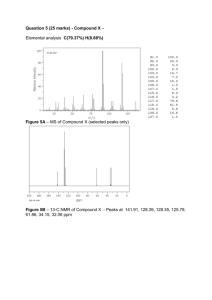NMR Workshop I Assignment Step 1. Learn what is meant by
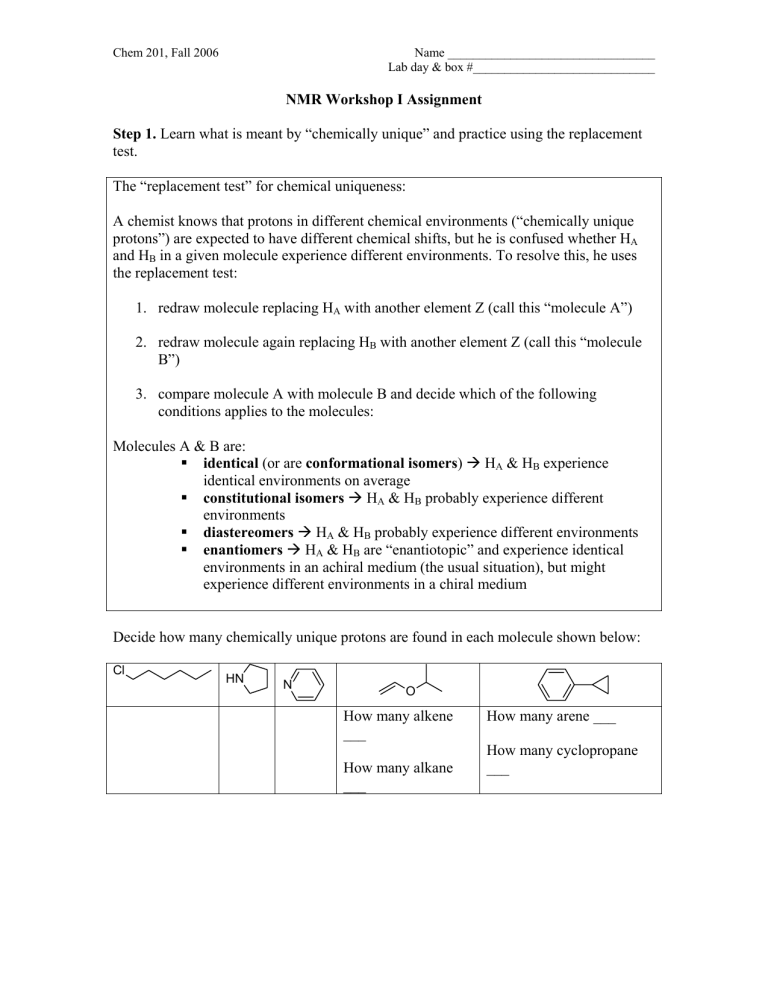
Chem 201, Fall 2006 Name _________________________________
Lab day & box #_____________________________
NMR Workshop I Assignment
Step 1.
Learn what is meant by “chemically unique” and practice using the replacement test.
The “replacement test” for chemical uniqueness:
A chemist knows that protons in different chemical environments (“chemically unique protons”) are expected to have different chemical shifts, but he is confused whether H
A and H
B
in a given molecule experience different environments. To resolve this, he uses the replacement test:
1.
redraw molecule replacing H
A
with another element Z (call this “molecule A”)
2.
redraw molecule again replacing H
B
with another element Z (call this “molecule
B”)
3.
compare molecule A with molecule B and decide which of the following conditions applies to the molecules:
Molecules A & B are:
identical (or are conformational isomers )
Æ
H
A
& H
B
experience identical environments on average
constitutional isomers
Æ
H
A
& H
B
probably experience different environments
diastereomers Æ H
enantiomers
Æ
H
A
& H
B
probably experience different environments
A
& H
B
are “enantiotopic” and experience identical environments in an achiral medium (the usual situation), but might experience different environments in a chiral medium
Decide how many chemically unique protons are found in each molecule shown below:
Cl
H N
N
O
___
How many alkane
___
How many cyclopropane
___
Chem 201, Fall 2006 Name _________________________________
Lab day & box #_____________________________
Step 2.
Learn to assign the peaks in some typical spectrum. For each spectrum, you must:
1.
identify confounding peaks (give the chemical shift and the cause of the peak)
2.
use one line of table for each chemically unique type of proton
3.
fill in all info for the proton: chemical shift, #H, coupling info (pattern, J), and assignment
O
H
3
CO
H panisaldehyde
Confounding peaks (if any): chemical shift
(ppm) (s, d, t, q, …, m)
J
(Hz) assignment
Chem 201, Fall 2006 Name _________________________________
Lab day & box #_____________________________
Br
2-bromopropane chemical shift
(ppm)
Confounding peaks (if any):
(s, d, t, q, …, m)
J
(Hz) assignment
OH
2-butanol chemical shift
(ppm)
Confounding peaks (if any):
(s, d, t, q, …, m)
J
(Hz) assignment
Chem 201, Fall 2006 Name _________________________________
Lab day & box #_____________________________
Step 3.
Learn to process & print NMR data using SpinWorks. Do this for your spectrum of isopentyl acetate by performing these steps:
1.
Open SpinWorks manual (use link on 201 home page ). Read manual and perform all steps in the tutorial through Print (Full) Spectrum using your isopentyl acetate data.
2.
Using the full spectrum, try to complete as much of the chart (below) as you can.
(Hint: you won’t be able to complete the entire chart, but you should be able to figure out: how many types of H are in your compound and their approximate chemical shifts.)
3.
At this point, you will want to print expansions of your spectrum that include peak positions (in Hz) and integrals. You might be able to fit all of this data onto a single page by carefully adjusting the horizontal and vertical scales. However, you might find it more convenient to use two pages, one for the smaller peaks appearing between 1.5-4.3 ppm, and a second for the taller peaks appearing between 0.5-2.5 ppm. Once you have these data, complete the rest of the chart below by inserting integral and coupling pattern data.
Step 4.
Interpret your spectrum:
O
O Confounding peaks (if any): chemical shift
(ppm) (s, d, t, q, …, m)
J
(Hz) assignment
Step 5 (optional).
Learn to write your spectra data for the Experimental section of a lab report. See (online lab manual: appendix: writing a report: Experimental section) http://academic.reed.edu/chemistry/alan/201_202/lab_manual/appendices/writing_a_repo rt.html#experimental
Write your NMR data on a single line here (this is the same way you will write it in the
Experimental section of your lab report):

